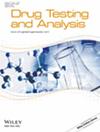Identification of Hexahydrocannabiphorol Metabolites in Human Urine
Abstract
Hexahydrocannabiphorol (HHCP) is an emerging semisynthetic cannabinoid, which has been known since 1942 from research of tetrahydrocannabinol (THC) analogs and homologs. After the ban of hexahydrocannabinol (HHC) in many European Countries HHCP emerged as a replacement among other similar compounds. First countries already placed HHCP under their narcotic substance law. The aim of this research was to identify human Phase I and II metabolites in urine after oral HHCP consumption. Enzymatic immunoassays of urine samples were tested negative for cannabinoids after a single oral consumption of 4-mg HHCP from a Δ9-THC abstinent volunteer. The HHCP sample consumed in the self-experiment was purchased from an online store and analyzed beforehand using GC–MS. LC–HR-MS/MS and GC–MS after derivatization were used for the identification of metabolites. Hydroxylated metabolites were found with hydroxylation on the side chain or on the alicyclic part of the molecule. Bishydroxylated HHCP metabolites were found in similar abundance as the monohydroxy metabolites. All of the bishydroxylated metabolites besides a minor metabolite had a hydroxyl group on the side chain and another hydroxyl group on the alicyclic part of the molecule. In addition, the corresponding glucuronides were identified by LC–HR-MS/MS. The exact positions and stereochemistry of the hydroxylation sites could not be determined. Due to the extensive metabolism of HHCP and the lacking cross-reactivity of urine samples after consumption in Δ9-THC specific immunoassays, it is recommended to include HHCP metabolites in routine screening methods. Monohydroxylated and bishydroxylated metabolites of HHCP and their respective glucuronides are suggested as forensic targets.





 求助内容:
求助内容: 应助结果提醒方式:
应助结果提醒方式:


